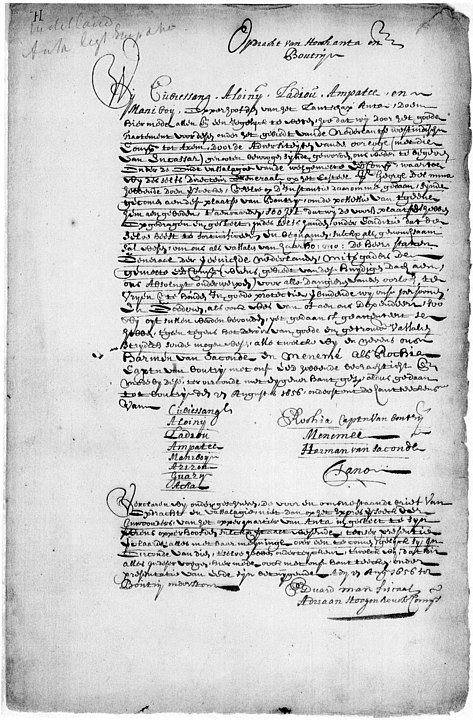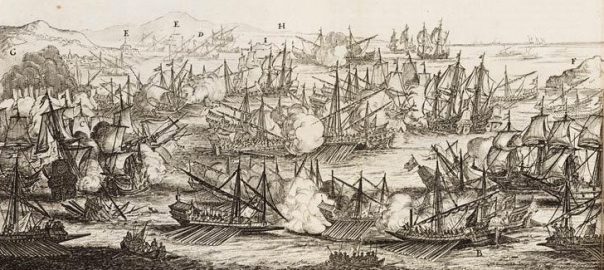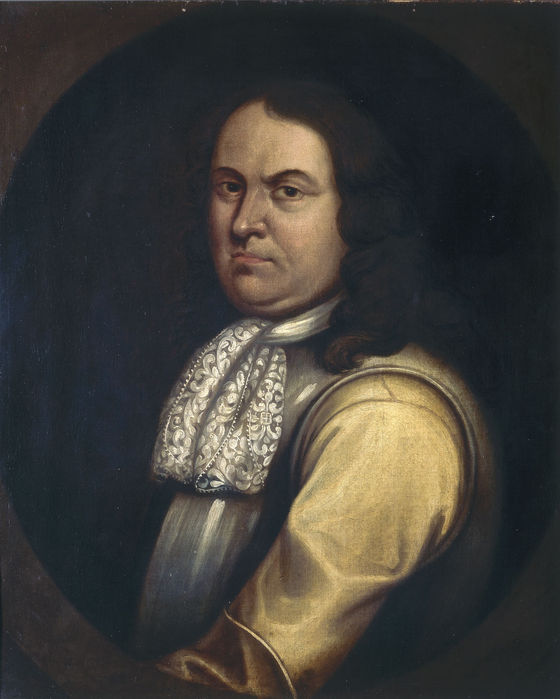The year 1656 CE saw several developments in the ongoing history of West European empires. Let’s look at a small news item from Istanbul first. Then we’ll look at Dutch colonial doings worldwide before coming to the escalating conflict between England and Spain.
A new vizierial dynasty in Istanbul
Köprülü Mehmed Pasha had been born in Albania in around 1575, seized by the Ottomans in some war and raised in their devşirme slave-training system. His first position in the cavalry was in the town of Köprü in northern Turkey, which became his eponym. His page on English-WP tells us that his “early rise was facilitated by his participation in patronage networks with other Albanians in the Ottoman administration. His main patron was the Albanian Grand Vizier Kemankeş Kara Mustafa Pasha.”
He became governor of several different provinces (sequentially) and “cultivated many friendships at the sultan’s court, especially with the Queen Mother Turhan Hatice Sultan, mother of the minor sultan Mehmed IV.” Turhan Hatice, you may recall, had recently won out over her mother-in-law Kosem Sultan in the “Queen Mother battles of Topkapi.” In 1656 Mehmed IV was still only 14 years old.
By then there was an intense political crisis in Istanbul:
The war in Crete against the Venetians was still continuing. The Ottoman Navy… in May 1656, was defeated by the Venetian and Maltese navy at the Battle of Dardanelles (1656) and the Venetian navy continued the blockade of the Çanakkale Straits cutting the Ottoman army in Crete from Constantinople, the state capital. There was a political plot to unseat the reigning Sultan Mehmed IV led by important viziers including the Grand Mufti Hocazade Mesut Efendi. This plot was discovered, and the plotters were executed or exiled…
So they called in Köprülü Mehmed Pasha to be Grand Vizier, though he was already 80 years old:
he accepted the position of Grand Vizier on 14 September 1656. As a condition of his acceptance, Köprülü demanded that the sultan decree only what Köprülü approved, allow him to make all the appointments and dismissals, and refuse to hear or accept any malicious stories that might be spread about him. He was given extraordinary powers and political rule without interference, even from the highest authority of the Sultan.
This was how he set about ruling:
[H]is first task was to advise Sultan Mehmed IV to conduct a life of hunts and traveling around the Balkans and to reside in the old capital of Edirne, thus stopping his direct political involvement in the management of the state. On 4 January 1657, the household cavalry Sipahi troops in Constantinople started a rebellion and this was cruelly suppressed by Köprülü Mehmed Pasha with the help of Janissary troops. The Greek Orthodox Patriarch of Constantinople was proven to be in treasonous contacts with the enemies of Ottoman state and Köprülü Mehmed Pasha approved of his execution.
Rivals and unfriendly religious leaders were banished or executed. The support of the Janissaries was obtained once he was secure in his office. Köprülü centralized power in the empire, reviving traditional Ottoman methods of governing. He ordered those who were suspected of abusing their positions or who proved to be corrupt to be removed or executed. Those who failed at their tasks were punished severely, and unsuccessful military commanders often paid the supreme price. When Grand Admiral Topal Mehmed Pasha failed to break the Venetian blockade of the Dardanelles on 17 July 1657, Köprülü executed him and his principal officers on the spot. When rivals complained to Mehmed IV about the Grand Vizier’s methods, Köprülü resigned, complaining that the Sultan had violated their agreement. Mehmed immediately asked Köprülü to return as Grand Vizier, because his methods showed such success at restoring Ottoman power.
Long story short he soon broke the Venetian blockade of the Dardanelles, conducted a successful campaign in Transylvania, and brutally put down a mutiny of 30,000 troops in Aleppo, who were supposed to be guarding the frontier with the Safavid Empire.
Just to complete his story: In 1661 Köprülü Mehmed Pasha died, having persuaded the Sultan to appoint his son in his place– an appointment that would then lead to four more Grand Viziers from the Köprülü dynasty. This is how WP describes his legacy:
He also allegedly advised the sultan never to take advice from a woman [!], never to appoint a minister who was too wealthy, to always keep the treasury full, and to always keep the army on the move… He left behind a well-tuned administrative machine, having restored to the Ottoman Empire its reputation for military aggressiveness and its former prestige and power internally and externally.
The banner image above is a detail from a Dutch rendering of the 1656 Battle of the Dardanelles.
Dutch empire news on two continents
The Dutch Empire and its two major (for-profit!) wings, the East India Company (VOPC) and West India Company (GWC), were clearly much more influential in building the globalized world of the 17th century than was the Ottoman Empire. But I’m going to race through the two major developments of 1656 in Dutch empire-building. Here they are:

- In East Asia, the VOC masters at Batavia sent a “tribute mission” to Qing/Manchu-ruled China in 1656. Here’s what I learned from this source about it: “The consolidation of the Manchu rule saw the Dutch send tribute missions to China in 1656, 1663 (not formally accepted), 1667 and 1686 in the hope of gaining trading concessions. Dutch requests included permission to trade every year, a fortified trading post in the Amoy-Quemoy area and a joint military attack on Taiwan after its fall to Ming loyalists. Successful joint military operations were undertaken against Quemoy but disagreements between the two allies decreased their desire for future cooperation. Meagre results from tribute missions and disappointing profits from trade led to a decline in Dutch interest in trading directly with China.”
- In West Africa, in August 1656, the GWC signed the Treaty of Butre with the representatives of the Ahanta people on the Gold Coast, not far from where they were already running the big slave-trading post at Elmina. Here’s what English-WP says about the new treaty: “After the Dutch managed to dislodge the Swedes from Butre and began building Fort Batenstein at that site, the leaders of the Dutch West India Company thought it beneficial to negotiate a treaty with the local political leadership in order to establish a peaceful long-term relationship in the area… This treaty established a Dutch protectorate in the area, and established diplomatic ties between the Dutch Republic and the Ahanta. The treaty’s arrangements proved very stable and regulated Dutch-Ahanta diplomatic affairs for more than 213 years.”
Cromwell escalates the war with Spain
In 1655, England’s Oliver Cromwell had sent a naval expedition to start ousting Spain from its strongholds in the Caribbean. That had mixed results, as we know, though the English did manage to take Jamaica from Spain. Then in early April 1656, Spain’s King Philip IV signed the Treaty of Brussels with Charles II, the never-yet-crowned aspirant to the English throne.
Here’s what WP tells us about this deal:
In exchange for future Spanish military support for a potential restoration, Charles agreed to raise forces to fight for Spain in the Franco-Spanish War. He also pledged to stop English colonisation in the Americas and to return any territory that would be taken by the Commonwealth from Spain. He also agreed to help Spain fight against Portugal’s attempt to regain independence.
Late that April, Cromwell sent his naval ace Robert Blake to the coast of Spain itself, with a fleet of around 40 vessels, with the objective of blockading Spain’s main port at Cadiz.
The blockade dragged on a bit, with the Spanish in Cadiz just remaining on the defensive. Blake sent one of his captains to raid other ports in Northern and Southern Spain, which they did with a modicum of success, and meanwhile settled in for a long siege of Cadiz by getting renewed supplies of fresh water from “the African coast” (presumably, nearby Morocco?)
Then this happened:
On the evening of 8 September, one of Blake’s captains, Richard Stayner, intercepted a Spanish treasure fleet and captured or sank all but two of its ships. The loss of the cargoes of the ships captured or sunk by the English was a serious blow to the economy of Spain with an estimated loss of £2,000,000. For the first time in naval history, Blake kept the fleet at sea throughout an entire winter in order to maintain the blockade against Spain.
In February 1657, Blake received intelligence that the plate fleet from New Spain was on its way across the Atlantic. Leaving two ships to watch Cadiz, Blake sailed from there to attack the plate fleet, which had docked at Santa Cruz on Tenerife in the Canary Islands to await an escort to Spain. In April in the Battle of Santa Cruz de Tenerife, Blake completely destroyed the Spanish merchant convoy—the West Indian Fleet—however, the fleet had landed the bullion before the battle. Blake was unable to seize it, but it was also unavailable to the government in Madrid.
The short term effect of Blake’s blockade of Spain and his victory at Santa Cruz was the disruption of the Spanish economy, which depended upon silver and gold from the Americas and thereby damaged Spain’s capacity for waging war. The English lost 1,500 to 2,000 merchant ships to Spanish privateers and instead of using captured English ships to replace their destroyed convoys, the Spanish government placed the care of Spanish trade in the hands of neutral Dutch merchantmen.
That seems like a large loss of English merchant vessels, and indicates to me that the Spanish still had some impressive privateering capabilities– most of which was operating out of the Spanish-Netherlands port of Dunkirk. Meantime, as indicated there, the UP-Dutch shipowners definitely came out ahead!



